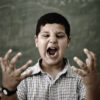
10 Signs Your Child May Be Suffering from a Vision Problem
A child’s performance in school can be either a source of pride or frustration for parents and children alike. Sometimes, parents tend to overlook small signs that could be associated with a bigger problem, like eyesight issues. Especially when it comes to in-class behavior, reading, and concerns about learning disorders, like ADD/ADHD or dyslexia, parents should consider ruling out any vision problems first.
Consider how much of what a child learns is visual; some numbers project that as much as 90 percent of curriculum taught is learned through visual means. A child can hardly be expected to understand that they’re getting frustrated because they can’t see well – they have no reference point for what their vision should be.
According to the American Public Health Association, over 25 percent of children have an undiagnosed eyesight issue, whether mild, moderate, or severe. This leads to a lowered ability to learn in a school setting and maintain their attention span. It can also lead to increased behavioral problems as children act out in frustration.
 Because of the high incidence of vision problems in school-aged children, there is concern about a correlation between behavioral problems, habits, and more damage to a child’s eyes if not corrected. Many schools provide hearing and vision testing, but these tests are not perfect. Parents should be ready to test their children’s eyesight if anything concerning begins to happen with their education. This is why regular eye exams are so important for children.
Because of the high incidence of vision problems in school-aged children, there is concern about a correlation between behavioral problems, habits, and more damage to a child’s eyes if not corrected. Many schools provide hearing and vision testing, but these tests are not perfect. Parents should be ready to test their children’s eyesight if anything concerning begins to happen with their education. This is why regular eye exams are so important for children.
Here are 10 signs that your child may actually have a vision problem:
1. Clumsiness
Do your children often trip, spill things, or knock things over that they didn’t know were there? Often, children with vision problems come home from school with scrapes or get teased for having “two left feet.” While their clumsiness may seem harmless and just part of a kid’s life, it’s important to rule out vision problems before you record too many wipeouts.
2. Restlessness/Inability to Sit Still
A child with vision problems can often be restless or seem to lack attention during “close work,” which requires them to pay attention and look at something for an extended period. They often do not want to sit and focus on their homework. Or they move a lot because it hurts to focus their eyes on something at a close distance.
3. Exhaustion After School
Sometimes, school is just plain tiring, and your child is worn down by the time he or she gets home. However, if it becomes a constant, and you’re worried about what exactly is so exhausting, it could be that vision problems are making it hard for your child to stay awake. Many vision problems make the eyes tired. This can make children feel more drained, even just from staring at something for long periods of time.
4. Headaches and Itchy Eyes
If a child complains that their head or eyes hurt after staring at a board, their homework, or a screen of any sort, it could be that they have an eye abnormality. There are also other signs, such as red, watery, or itchy eyes, as well as excessive blinking. Pay attention to the signs, as they can be a huge clue that something is up.
5. Bad Habits
Does your child squint to read? Does he or she tip their head to one side when looking at something? Some children physically move closer to an object to see it or move their heads backward. These are signs that their eye muscles may not be working properly or an issue with focus (like astigmatism). Of course, if your child has a habit of chewing with his or her mouth open, or leaving laundry on the floor, that’s another bad habit you’ll have to break on your own.
6. Slipping Grades
Have you noticed your child getting lower grades? Has their reading performance begun to regress, or just never progress? Children with visual difficulties tend to avoid doing the work that gets them good grades, or they just get questions or words wrong, and eventually, their grades start to slip. This is a big clue, especially as children begin to age out of their toddler years (and the eyes develop even more).
7. Sloppy Handwriting
This is a controversial standard for eyesight problems, but it is one worth noting. Not every kid with sloppy handwriting (which is every kid when they’re first learning how to write) has a vision deficit. However, a child may have trouble tracking where they left off when writing, or may not be able to see lines or write in a linear way. It is not recommended to ask other people with sloppy handwriting if they’ve had their eyes checked lately, however.
8. Behavioral Diagnosis
According to the CDC, as much as 9.8 percent of children have been diagnosed with ADD or ADHD in the United States alone, and many of these children are placed on a class of stimulant drugs that don’t seem to help their behavior. It is possible that their behavior could be related to internal issues, such as vision problems.
9. Concerns About Dyslexia
According to the Dyslexia Center of Utah, many children are affected by dyslexia, with some numbers projecting as much as 15 to 20 percent of the school-age population. If your child confuses words, letters (“b” and “d”), directions (left and right), or numbers (6 and 9, 1 and 7), you may be concerned about dyslexia, but it’s important to rule out vision issues first.
10. Homework Hazards
Does your child fight you tooth and nail to avoid homework time? Do they cry whenever you tell them it’s time to sit down and read? There is no doubt this is incredibly difficult to deal with, but it may be a sign that they cannot see well. Frustration with their inability to do something may lead to the tantrums many parents encounter on a daily basis. If you feel like crying just as much as your child does when it’s time to do homework, it might help to get their eyes checked just to be safe.
Every parent wants their child to succeed in school. It’s difficult to see your child having problems in school, and as the parent, you need to figure out what exactly is preventing your child from doing his or her best. While this list is not exhaustive, these clues are very helpful when you’re attempting to evaluate a child’s behavior. It may be that you’ve never worried about their eyesight, but have had issues with attention span or performance in school.
Many times, eye issues go undiagnosed for years. There are numerous ways to help your child improve his or her eyesight, but the first step is recognizing the signs.
Our Rebuild Your Vision Ocu-Plus Formula Contains All 17 Vitamins, Minerals, and Herbal Supplements to Improve Your Eye Health!




Hi Tyler, keep up your good work.
My son will 4 in Feb. but traits of poor eyesight that he would have gotten from me. I do not want him to wear glasses like I do. What help is there for him.
Thanks
A good possible reason for education failures
sir my eyesight is very weak my eye no. is -3.5 for left eye and -3 for right eye is it possible to remove my spectacles naturally sir i am a sportsman and i found it very difficult to play while wearing spectacles sir i can do anything in order to improve my eyesight